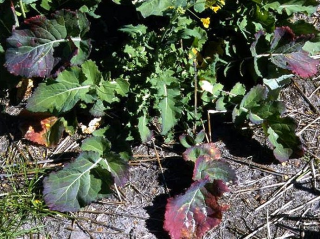Beet western yellow virus in canola
- Katanning
- Tambellup

Purpling of leaves and mottled looking canola at two locations in Katanning and Tambellup prompted an agronomist to take samples and send leaves to the department’s Diagnostic Laboratory Services (DDLS) for virus testing. The canola was sown in March at both locations and the canola at both locations was adjacent to a neighbours’ paddock that had unsprayed volunteer canola over summer. The crops are now at the big bud growth stage with some flowering. Turnip aphids and cabbage aphids were also found in high numbers with a few green peach aphids (GPA).
Virus testing by the department’s DDLS found that the Katanning canola crop had 5-10% beet western yellow virus (BWYV) infection around the beginning of bolting. This is likely to only result in less than 10% yield loss. However, further seed yield and quality losses are possible if rapid BWYV spread occurs in July from widespread proliferation of GPA colonies.
There are still visible numbers of GPA, turnip and cabbage aphid in the crop. The cooler weather is expected to decrease the aphid build up and some aphids have been found with fungal infections and some have been parasitised.
BWYV is an aphid-borne virus that causes yield and quality losses in canola crops. It also infects other crop and pasture species including mustard, chickpea, faba bean, field pea, lucerne, medic and subterranean clover. BWYV is found widespread throughout the Wheatbelt.
BWYV infection causes reddening, purpling or yellowing of the lower leaves of canola plants. Plants infected early (well before flowering) are often pale and stunted and these plants produce few flowers or seeds. Symptoms are milder and stunting is lacking with late infection. Leaf symptom type and severity differ depending on plant age at infection, environmental conditions and the canola variety involved. Symptoms of BWYV in canola can be confused with those caused by nutrient deficiencies, waterlogging or other plant stresses that cause yellowing, reddening or purpling of lower leaves.
BWYV is not seed-borne and survives from one growing season to the next in over-summering canola, broadleaf weed species, perennial legume pastures and some native plants. BWYV is spread by several aphid species that colonise canola including its principle vector, the green peach aphid and the minor vector, the cabbage aphid.
The virus infects phloem cells in a plants’ vascular system but not its other tissues. BWYV is transmitted persistently, that is, once an aphid feeds on the phloem cells of an infected plant the aphid acquires the virus. When the infective aphid then probes the phloem of a healthy plant it infects that plant. The aphid continues transmitting BWYV for the rest of its life so can infect many more healthy plants.
From previous field trials done by the department, when canola plants became infected very early (flowering) and the BWYV incidence in crops reached 96-100%, overall seed yield losses were up to 46%. For every 1% increase in the level of BWYV in a canola crop, there was a 6-12kg/ha decline in yield resulting from formation of fewer seeds. BWYV infection diminished seed quality by decreasing oil content (up to 3%) and increasing erucic acid (up to 44%). If the crop becomes infected late (podding), spread was much less and yield and quality losses were minimal.
BWYV spread can be controlled by insecticides including seed dressings and foliar spray but care must be used to avoid development of sulfoxaflor and imidacloprid resistance in green peach aphids from unnecessary or inappropriate use of these chemicals.
For more information on BWYV see the department’s Diagnosing beet western yellow virus in canola page.
For further information contact Ben Congdon, Research Officer, South Perth on +61 (0)8 9368 3499.
